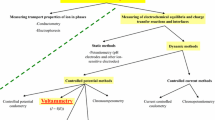Summary
Transfective poliovirion RNA after inactivation by the inactivator or inactivators formed from copper and an impurity or impurities in reagent-grade phenol sediments more heterogeneously and, on the average, more slowly than intact transfective RNA. The data are consistent with the hypothesis that the inactivator causes scission of the viral RNA molecules.
Similar content being viewed by others
References
Dubes, G. R., Wegrzyn, R. J., Masoud, A. N.: Inactivation of transfective poliovirion RNA by a product or products of the interaction of trace copper with an impurity or impurities in reagent-grade phenol. Arch. Virol.66, 27–44 (1980).
Douglas, J. D., Vasington, P. J., Noel, J. K.: Viral spectrum of an established chimpanzee liver cell line. Proc. Soc. exp. Biol. (N.Y.)121, 824–829 (1966).
Author information
Authors and Affiliations
Additional information
With 2 Figures
Rights and permissions
About this article
Cite this article
Dubes, G.R., Al-Moslih, M.I. Effect of inactivator(s) formed from copper and phenol impurity(ies) on the sedimentation rate of transfective poliovirion RNA. Archives of Virology 66, 45–51 (1980). https://doi.org/10.1007/BF01315043
Received:
Accepted:
Issue Date:
DOI: https://doi.org/10.1007/BF01315043




